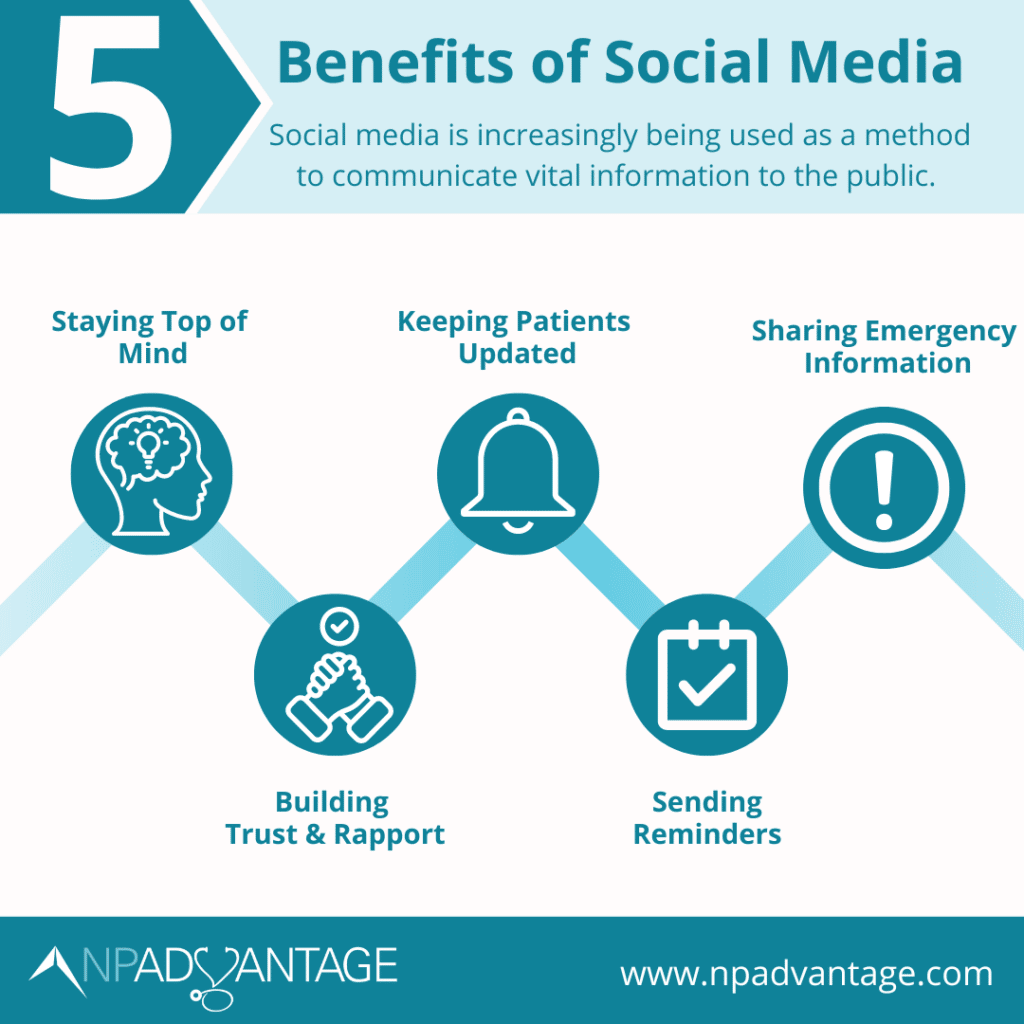Once you start running your practice, how often do you expect to see a patient – once a month, or once a season? When you have social media to keep you connected with patients throughout the year, you can easily maintain relationships outside of scheduled visits – no matter the frequency of patient visits.
If a patient wants to keep up with you by following you on social media, will they be able to find you? If a prospective patient wants to learn more about what you have to offer, what will they see when they find your social media accounts? As you work to grow your practice and promote the nurse practitioner-led model, social media and patient engagement help you cultivate valuable relationships.
Using Social Media to Virtually Spend More Time with Patients
Because social media was designed to encourage engagement and stimulate conversations, it is a prime opportunity to have ongoing communication with the community. With every post you express your values, what you care about, and what motivates you. The role of social media in healthcare is for patients to really get to know you and your practice, as they can only learn so much about you from a brief appointment.
As you grow a following, you will have the chance to share exciting news about your practice, provide updates about current health topics, and remind patients to take care of their health. It takes time to build a following for social media and patient engagement, so the sooner you can get set up, the better.
Getting Started on Social Media as a Nurse Practitioner
It is best to keep your practice’s accounts separate from your personal social media account. For example, your practice’s Facebook account will not have the “Add Friend” button – instead, the user can follow you.
To get started, set up a business account on a major social media platform. These accounts are free to set up and provide features to manage your engagement. Fill out your account with your practice’s name, services, hours, location, and mission statement.
While multi-provider practices tend to have a business logo as the profile picture, as a single-provider NP practice, you may opt for a friendly and professional photo of yourself or your team.
Once you have all your profile set up, invite others to like and follow your account.

How Does Social Media Influence Patient Engagement?
It has been said that social media use in healthcare serves five main functions:
- Patient education
- Crisis communications
- Community outreach
- Public relations
- Customer service
These functions encourage patients to engage in healthcare for themselves and their loved ones. While social media was built for entertainment, it is increasingly being used as a method to communicate vital information to the public.
What you can expect to achieve with social media and patient engagement:
- Showing up where patients already spend a lot of time – While the modern patient gets reminder texts and emails, social media is another channel to turn their attention to health matters.
- Staying top of mind – There is so much competition out there. When you show up in your patients’ feeds regularly, you help them remember you the next time they need care. Your post may even remind them that they are due back for a visit and need to make an appointment.
- Humanization – Fun and personal posts make you more relatable to patients by adding more dimension to your persona – communicating both your personality and your values.
- Being the voice of reason – 60% of social media users trust their provider’s information over other sources. You are a trusted source of health information on social media. This means providing timely wisdom about current hot topics, which is especially necessary when there is so much misinformation circulating online.
- Being known for your content – It is important to set yourself apart from the many other care options available to patients. What would you like to be known for? What kind of topics and content can you put out there that hardly anyone else is bringing up? What kind of content will resonate best with the patient population you serve?
- Keeping patients updated – Because the most recent posts tend to stay top-of-feed, social media is an ideal channel for sharing news and updates. Will your office be offering new services? Closing for a short time due to vacation? Anything you would put in a newsletter you can post on social media.
- Emergencies – Social media is ideal for urgent communication. During a major event either locally or nationally, people tend to check their social media to keep tabs on loved ones and receive updates from official sources. Use your social media accounts to make statements in response to urgent matters and offer helpful, relevant resources to patients.
- Gentle reminders – A patient may never open your emails, portal messages, or texts, but with social media you can remind people of recurring health needs such as flu shots, allergy shots, well child checks, mammograms, or other routine screenings. Social media posts are one more way to encourage patients to stay engaged with their health needs.
- Building trust and rapport – An active social media presence builds your credibility. For example, if you post a video of yourself and one of your patients vouches for your expertise in the comments, this is social proof that you are trustworthy.
However, if a patient leaves a complaint on your page, you have the opportunity to preserve the relationship by addressing the matter with empathy. Positive interactions not only strengthen your bond with existing patients, but also signal to the public that patients appreciate you and you are open to their feedback.
Social media tip: If a patient posts a complaint in public view such as a post tagging you, posting on your wall, publishing a review, or leaving a comment on one of your posts, kindly invite them to take the communications to a private channel. This protects your patient’s privacy.
Promoting the NP Care Model and Growing Your Practice Through Social Media Marketing
Because of all the benefits people get from social media, they often forget what these platforms are really built for – to build and sell target audiences for advertisers. Platforms want business accounts to pay to promote themselves, healthcare included. Social media is one of many avenues for digital marketing for nurse practitioners.
Facebook ads are less expensive compared to other forms of advertising such as Google Ads. These ads are often considered to be a better value because of how specific you can be for whom you are trying to reach. Social media platforms store rich details about their users, and this is how they can help you carve out a niche audience for healthcare social media marketing.
Do you have to pay to participate in social media and patient engagement? No, but keep in mind that – by design – your followers will see posts from paid ads, friends, and family more often than they will see your content. But because of how social media has become a part of normal everyday life for most consumers, it is better to be active on social media than to not have a presence at all.
Social Media Management is Time Consuming – NP Advantage Can Help
With your patients as the constant focus of your practice, marketing tasks like social media maintenance will soon fall by the wayside. This is a real dilemma as it takes dedication and consistency for social media and patient engagement to be fruitful for your NP practice.
Our Practice Marketing solutions take this task off your hands as our healthcare social media management specialists post on your behalf based on a content calendar suited for your NP practice.

